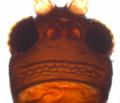Monilothrips kempi
Recognition data
Distinguishing features
Both sexes fully winged. Body dark brown, legs brown with base and apex of tibiae yellow, also tarsi; antennal segments I–II brownish yellow, III yellow, IV–V yellow at base; fore wing light brown, pale sub-basally. Antennae 8-segmented, III – IV with sensoria forked, VIII twice as long as VII. Head with conspicuous band of 3 rows of reticles at posterior, ocellar setae III arise inside triangle, three pairs of prominent postocular setae. Pronotum with stout transverse carina parallel to posterior margin, 2 pairs of long posteroangular setae, outer longer than inner, one pair of long anteroangular setae. Mesonotum reticulate, lateral setae short. Metanotum reticulate medially, median setae near posterior margin. Tarsi all 2-segmented. Fore wing with two complete rows of long setae, postero-marginal cilia wavy. Abdominal tergites II–VIII reticulate, median setae small, posterior margins with broad craspedum; tergite X with complete longitudinal split. Sternites with three pairs of long marginal setae.
Male without sternal pore plates.
Related and similar species
Only one species is placed in the genus Monilothrips. Within the Panchaetothripinae, this resembles Hercinothrips in having the tarsi 2-segmented and in having two complete rows of setae on the forewing.
Taxonomic data
Current valid name
Monilothrips kempi Moulton
Original name and synonyms
- Monilothrips kempi Moulton, 1929: 94
- Monilothrips montanus Jacot-Guillarmod, 1942: 64
Family placement
Thipidae, Panchaetothripinae
Biological data
Life history
Larvae and adults feed on fern fronds.
Host plants
Recorded from various ferns, including Blechnum australe, Adiantum aethiopicum, Woodwardia sp., Polystichum sp., Pellaea andromedifolia.
Tospoviruses vectored
None
Crop damage
None
Distribution data
Area of origin
Possibly Africa or India
Distribution
North and South India, South Africa, California (Wilson, 1975)






